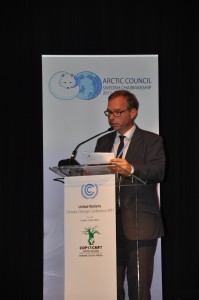The Arctic in Durban: a schizophrenic “canary in the coal mine”
Despite taking place on the opposite side of the planet, the annual UN climate conference (COP17) was surely one of the most important event of the year for the future of the Arctic.
Keeping in mind that the Arctic is warming twice as fast as the rest of the planet, the outcome of these international negotiations has a particularly high impact on the environment of the High North and on its local communities.
The Arctic remains a key reference in the climate discourse, polar bears and cracking sea ice remaining for instance two of the most iconic images used to illustrate the phenomenon. Despite being often described as a “canary in the coal mine”, the Arctic has however never been the focus of much attention in the international climate talks (only two out of hundreds of documents adopted in these negotiations over the past twenty years include a reference to the Arctic).
In the past, the Arctic has been evoked at the climate negotiations mainly through two perspectives. The release of important scientific reports such as the Arctic Climate Impact Assessment increased the visibility among the climate change community of Arctic issues. Also indigenous people representatives have repeatedly highlighted the impact of climate change on their communities, for instance through the Many Strong Voices project, which builds a link between small island states and Arctic indigenous communities. This year, two youth came from Nunavut in order to share at the conference an Inuit perspective on the impacts of climate change.
 In Durban, Sweden, as chair of the Arctic Council, organized a parallel event during which impacts of climate change in the Arctic were discussed. During the event, Mr. Anders Flanking read a statement by Carl Bildt, Swedish Minister of Foreign Affairs and chair of the Arctic Council, urging “all countries to take decisive action, recognizing that deep cuts in global Greenhouse Gas emissions are required according to science with a view to reducing global Greenhouse Gas emissions so as to hold the increase in global average temperature below 2 C above pre-industrial levels.” This call built on the Nuuk Declaration adopted by the Arctic Council in May, in which the 8 Arctic States “urged” for the first time other nations to take urgent action in order to mitigate climate change. Jens B Fredriksen, deputy Prime Minister of Greenland, also joined the panel highlighting the challenges that Greenland faces due to climate change, as well as potential opportunities that might arise from it for Greenlandic economy.
In Durban, Sweden, as chair of the Arctic Council, organized a parallel event during which impacts of climate change in the Arctic were discussed. During the event, Mr. Anders Flanking read a statement by Carl Bildt, Swedish Minister of Foreign Affairs and chair of the Arctic Council, urging “all countries to take decisive action, recognizing that deep cuts in global Greenhouse Gas emissions are required according to science with a view to reducing global Greenhouse Gas emissions so as to hold the increase in global average temperature below 2 C above pre-industrial levels.” This call built on the Nuuk Declaration adopted by the Arctic Council in May, in which the 8 Arctic States “urged” for the first time other nations to take urgent action in order to mitigate climate change. Jens B Fredriksen, deputy Prime Minister of Greenland, also joined the panel highlighting the challenges that Greenland faces due to climate change, as well as potential opportunities that might arise from it for Greenlandic economy.
Despite the commitment expressed by all eight Arctic States in the Nuuk Declaration, their governmental delegations adopted very different roles during the Durban conference. The participation of Norway for instance will be remembered on the basis of the impassionate statement by Erik Solheim, Norway Minister of the Environment and International Development, on the last hours of the negotiations, calling for a bridge between the interest of some developed countries for a future legally binding instrument and the plea for equity made by some developing countries.
On the opposite side, the United States and Canada have emerged of the climate conference as the two of the main obstacles on the road to a stronger legal framework to curb carbon emissions. Canada’s unilateral decision to withdraw from the Kyoto Protocol earlier this month constitutes perhaps the most significant blow dealt over the past decade by any country to international climate action.
The outcomes of the Durban conference constitute a small step towards a new international agreement to address climate change. On the other hand, the COP17 did nothing to address the issue of the enormous gap existing between existing pledges for national mitigation action and the agreed objective of reducing average increase of temperatures to two degrees. Considering that the Arctic is warming faster than the rest of the planet, the current low level of commitment signifies that the region is heading towards radical physical changes. In this context, one can only regret that the consensus among the eight Arctic States affirmed in the Nuuk Declaration has not prevented some of them to take opposite stands in Durban.
picture credit: Arviat History Project and Adopt a Negotiator




-
Phindae
About the author
Sébastien Duyck
Passionate environmental advocate, PhD student (Human Rights and Environmental Governance). Following particularly UNFCCC, UNEP and Rio+20 processes
